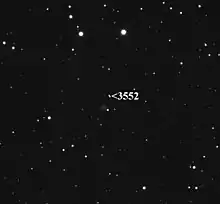.jpg.webp)
An extinct comet is a comet that has expelled most of its volatile ice and has little left to form a tail and coma. In a dormant comet, rather than being depleted, any remaining volatile components have been sealed beneath an inactive surface layer.
Due to the near lack of a coma and tail, an extinct or dormant comet may resemble an asteroid rather than a comet and blur the distinction between these two classes of small Solar System bodies. When volatile materials such as nitrogen, water, carbon dioxide, ammonia, hydrogen and methane in the comet nucleus have evaporated away, all that remains is an inert rock or rubble pile. A comet may go through a transition phase as it comes close to extinction.
Nature of extinct comets
Extinct comets are those that have expelled most of their volatile ice and have little left to form a tail or coma. Over time, most of the volatile material contained in a comet nucleus evaporates away, and the comet becomes a small, dark, inert lump of rock or rubble[1] that can resemble an asteroid.[2]

Other related types of comet include transition comets, that are close to becoming extinct, such as were looked for in the Hubble search for transition comets.[4] Comets such as C/2001 OG108 (LONEOS) may represent the transition between extinct comets and typical Halley-type comets (periods of 20–200 years) or long period comets (periods longer than 200 years).[5] Minor planets of the group of damocloids have been studied as possible extinct cometary candidates due to the similarity of their orbital parameters with those of Halley-type comets.[5]
Dormant comets
Dormant comets are those within which volatiles may be sealed, but which have inactive surfaces. For example, 14827 Hypnos may be the nucleus of an extinct comet that is covered by a crust several centimeters thick that prevents any remaining volatiles from outgassing.[6]
The term dormant comet is also used to describe comets that may become active but are not actively outgassing. For example, 60558 Echeclus has previously displayed a cometary coma and thus also has been given the cometary designation 174P/Echeclus. After passing perihelion in early 2008, centaur 52872 Okyrhoe significantly brightened.[7]
Distinction between comets and asteroids
When discovered, asteroids were seen as a class of objects distinct from comets, and there was no unified term for the two until "small Solar System body" was coined by the IAU in 2006. The main difference between an asteroid and a comet is that a comet shows a coma due to sublimation of near-surface ices by solar radiation. A few objects have ended up being dual-listed because they were first classified as minor planets but later showed evidence of cometary activity. Conversely, some (perhaps all) comets are eventually depleted of their surface volatile ices and develop the appearance of asteroids. A further distinction is that comets typically have more eccentric orbits than most asteroids; most "asteroids" with notably eccentric orbits are probably dormant or extinct comets. Also, they are theorized to be common objects amongst the celestial bodies orbiting close to the Sun.[8]
Roughly six percent of the near-Earth asteroids are thought to be extinct nuclei of comets which no longer experience outgassing.[6][9][10]
Extinct comets

Suspected or theorized extinct comets include:
- (137924) 2000 BD19
- 14827 Hypnos[6]
- 2101 Adonis
- 2015 TB145
- 3200 Phaethon[10][11]
- 3552 Don Quixote[10]
- P/2007 R5 (SOHO 1)[8]
- 1996 PW possibly an extinct long-period comet[12]
See also
References
- ↑ "If comets melt, why do they seem to last for long periods of time?", Scientific American, November 16, 1998
- ↑ "What is the difference between asteroids and comets?", Rosetta FAQ, ESA
- ↑ Harrington, James D.; Villard, Ray (6 March 2014). "RELEASE 14-060 NASA's Hubble Telescope Witnesses Asteroid's Mysterious Disintegration". NASA. Retrieved 6 March 2014.
- ↑ Space Telescope Science Institute, 'Amateur Astronomers Will Use NASA's Hubble Space Telescope', Media Release STScI-1992-23, 10 September 1992, retrieved 18 March 2009.
- 1 2 Abell, Paul A.; Fernández, Yanga R.; Pravec, Petr; French, Linda M.; Farnham, Tony L.; Gaffey, Michael J.; Hardersen, Paul S.; Kušnirák, Peter; Šarounová, Lenka; Sheppard, Scott S. (2003). "Physical Characteristics of Asteroid-like Comet Nucleus C/2001 OG108 (LONEOS)". 34th Annual Lunar and Planetary Science Conference. 34: 1253. Bibcode:2003LPI....34.1253A.
- 1 2 3 Whitman, Kathryn; Morbidelli, Alessandro; Jedicke, Robert (2006). "The Size-Frequency Distribution of Dormant Jupiter Family Comets". Icarus. 183 (1): 101–114. arXiv:astro-ph/0603106. Bibcode:2006Icar..183..101W. doi:10.1016/j.icarus.2006.02.016. S2CID 14026673.
- ↑ Trigo-Rodríguez, Josep M.; García Melendo, Enrique; García-Hernández, D. Aníbal; Davidsson, Björn J. R.; Sánchez, Albert; Rodríguez, Diego (2008). "A continuous follow-up of Centaurs, and dormant comets: looking for cometary activity" (PDF). European Planetary Science Congress. Retrieved 2008-10-12.
- 1 2 "SOHO's new catch: its first officially periodic comet". European Space Agency. 25 September 2007. Retrieved 2007-11-19.
- ↑ Morbidelli, Alessandro; Bottke, William F. Jr.; Froeschlé, Christiane; Michel, Patrick (January 2002). W. F. Bottke Jr.; A. Cellino; P. Paolicchi; Richard P. Binzel (eds.). "Origin and Evolution of Near-Earth Objects" (PDF). Asteroids III. University of Arizona Press: 409–422. Bibcode:2002aste.book..409M.
- 1 2 3 Lupishko, Dmitrij F.; di Martino, Mario; Lupishko, T. A. (September 2000). "What the physical properties of near-Earth asteroids tell us about sources of their origin?". Kinematika I Fizika Nebesnykh Tel, Suppl. 3 (3): 213–216. Bibcode:2000KFNTS...3..213L.
- ↑ Jewitt, David; Li, Jing (2010). "Activity in Geminid Parent (3200) Phaethon". The Astronomical Journal. 140 (5): 1519–1527. arXiv:1009.2710. Bibcode:2010AJ....140.1519J. doi:10.1088/0004-6256/140/5/1519. S2CID 6446528.
- ↑ "New Object Moves Like a Comet But Looks Like an Asteroid". www.jpl.nasa.gov. 22 August 1996. Archived from the original on 24 July 2008.
External links
- "Low Albedos Among Extinct Comet Candidates", 2001
- Dark, dangerous asteroids found lurking near Earth (NewScientist 5 March 2010)


.png.webp)